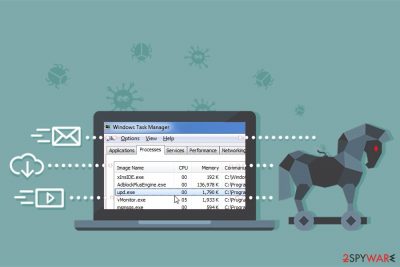Upd (Virus Removal Guide) - Free Instructions
Upd Removal Guide
What is Upd?
Upd is a malicious program which belongs to Trojan.Kryptic.AD infection

Upd is a Trojan horse which is often identified as Trojan.Kryptic.AD by antivirus tools. Usually, this malicious program can sneak into the system as Upd.exe file via spam emails, or together with rogue software downloads. Experts report that this cyber threat might record keystrokes, take desktop screenshots or run bogus commands on the system[1]. Thus, users should remove Upd if it is detected on their computers.
| Name | Upd |
|---|---|
| Type | Trojan horse |
| Also known as | Trojan.Kryptic.AD |
| File | Upd.exe |
| Danger level | High. It can make changes in the system |
| Distribution | Spreads as software cracks or fake updates on P2P networks or enters the system via spam emails |
| Compatible OS | Windows 10/8/7/XP |
| Size | 57 344 bytes |
| Removal | You can terminate Upd.exe and uninstall the Trojan horse with FortectIntego |
Upd.exe Trojan mostly targets Windows operating systems. According to the analysis, Upd.exe resides in C:\Program Files\Common Files directory where it takes up to 57 344 bytes of space. Although, experts report that this malicious program can also infect Mac computers.
Keep in mind that Upd.exe is an executable file, yet it doesn't open a visible window once executed. Thus, regular computer users can only detect it running in the Task Manager. The biggest concern about Upd is that it might perform the following malicious activities:
- Record and collect keystrokes;
- Take screenshots of the desktop;
- Access browsing history;
- Send the collected information to remote hackers.
If you fail to detect Upd.exe virus in time, this program might be used to gather private information. In other terms, Upd.exe Trojan can record your credentials or online banking details and upload them to a remote server which is controlled by cybercriminals.

Therefore, users are advised to stay cautious and remove Upd.exe immediately. Since Trojan horses are capable of hiding their malicious components across the system, people should employ reliable antivirus tools for the elimination procedure. We suggest using FortectIntego.
Be aware that it is essential to keep an eye on your bank account after Upd.exe removal. In case the malware managed to gather your credentials and passwords, they might be exploited in the future. Thus, report all unauthorized transactions to avoid financial losses and reset passwords right away.
Trojan horses can be distributed on peer-to-peer (P2P) networks
Commonly, people are highly eager to obtain legitimate software for free. Likewise, they search for software cracks or free updates on less than reliable sites or P2P[2] file-sharing pages. Unfortunately, this is one of the most common attack vectors how criminals manage to infiltrate malicious programs on the targeted systems.
Usually, they create legitimate-looking files which disguise Trojan horses and deceive inexperienced computer users. Therefore, it is vital to download applications only from verified websites. Additionally, be aware of malicious spam email attachments which can also hide the malware inside.
Upd.exe Trojan removal guidelines
Unfortunately, regular computer users are not experienced enough to remove Upd.exe on their own. Merely terminating the process in the Task Manager won't help you to get rid of the infection permanently. In fact, it would just stop Trojan's activity for a short period of time.
For permanent Upd.exe removal, you must disable the infection in the first place. For that, we suggest using instructions which are appended below. Once Upd.exe virus is inactive, you will be able to download and install a professional malware removal tool.
Researchers[3] note that it is vital to pick a reliable and robust antivirus. Thus, we highly recommend using FortectIntego, SpyHunter 5Combo Cleaner, or Malwarebytes. You should let it scan your system files thoroughly and perform automatic elimination for you.
Getting rid of Upd. Follow these steps
Manual removal using Safe Mode
Explaining how to boot the system into Safe Mode with Networking:
Important! →
Manual removal guide might be too complicated for regular computer users. It requires advanced IT knowledge to be performed correctly (if vital system files are removed or damaged, it might result in full Windows compromise), and it also might take hours to complete. Therefore, we highly advise using the automatic method provided above instead.
Step 1. Access Safe Mode with Networking
Manual malware removal should be best performed in the Safe Mode environment.
Windows 7 / Vista / XP
- Click Start > Shutdown > Restart > OK.
- When your computer becomes active, start pressing F8 button (if that does not work, try F2, F12, Del, etc. – it all depends on your motherboard model) multiple times until you see the Advanced Boot Options window.
- Select Safe Mode with Networking from the list.

Windows 10 / Windows 8
- Right-click on Start button and select Settings.

- Scroll down to pick Update & Security.

- On the left side of the window, pick Recovery.
- Now scroll down to find Advanced Startup section.
- Click Restart now.

- Select Troubleshoot.

- Go to Advanced options.

- Select Startup Settings.

- Press Restart.
- Now press 5 or click 5) Enable Safe Mode with Networking.

Step 2. Shut down suspicious processes
Windows Task Manager is a useful tool that shows all the processes running in the background. If malware is running a process, you need to shut it down:
- Press Ctrl + Shift + Esc on your keyboard to open Windows Task Manager.
- Click on More details.

- Scroll down to Background processes section, and look for anything suspicious.
- Right-click and select Open file location.

- Go back to the process, right-click and pick End Task.

- Delete the contents of the malicious folder.
Step 3. Check program Startup
- Press Ctrl + Shift + Esc on your keyboard to open Windows Task Manager.
- Go to Startup tab.
- Right-click on the suspicious program and pick Disable.

Step 4. Delete virus files
Malware-related files can be found in various places within your computer. Here are instructions that could help you find them:
- Type in Disk Cleanup in Windows search and press Enter.

- Select the drive you want to clean (C: is your main drive by default and is likely to be the one that has malicious files in).
- Scroll through the Files to delete list and select the following:
Temporary Internet Files
Downloads
Recycle Bin
Temporary files - Pick Clean up system files.

- You can also look for other malicious files hidden in the following folders (type these entries in Windows Search and press Enter):
%AppData%
%LocalAppData%
%ProgramData%
%WinDir%
After you are finished, reboot the PC in normal mode.
Remove Upd using System Restore
Alternative way how to reboot the computer into Safe Mode with Command Prompt:
-
Step 1: Reboot your computer to Safe Mode with Command Prompt
Windows 7 / Vista / XP- Click Start → Shutdown → Restart → OK.
- When your computer becomes active, start pressing F8 multiple times until you see the Advanced Boot Options window.
-
Select Command Prompt from the list

Windows 10 / Windows 8- Press the Power button at the Windows login screen. Now press and hold Shift, which is on your keyboard, and click Restart..
- Now select Troubleshoot → Advanced options → Startup Settings and finally press Restart.
-
Once your computer becomes active, select Enable Safe Mode with Command Prompt in Startup Settings window.

-
Step 2: Restore your system files and settings
-
Once the Command Prompt window shows up, enter cd restore and click Enter.

-
Now type rstrui.exe and press Enter again..

-
When a new window shows up, click Next and select your restore point that is prior the infiltration of Upd. After doing that, click Next.


-
Now click Yes to start system restore.

-
Once the Command Prompt window shows up, enter cd restore and click Enter.
Finally, you should always think about the protection of crypto-ransomwares. In order to protect your computer from Upd and other ransomwares, use a reputable anti-spyware, such as FortectIntego, SpyHunter 5Combo Cleaner or Malwarebytes
How to prevent from getting trojans
Protect your privacy – employ a VPN
There are several ways how to make your online time more private – you can access an incognito tab. However, there is no secret that even in this mode, you are tracked for advertising purposes. There is a way to add an extra layer of protection and create a completely anonymous web browsing practice with the help of Private Internet Access VPN. This software reroutes traffic through different servers, thus leaving your IP address and geolocation in disguise. Besides, it is based on a strict no-log policy, meaning that no data will be recorded, leaked, and available for both first and third parties. The combination of a secure web browser and Private Internet Access VPN will let you browse the Internet without a feeling of being spied or targeted by criminals.
No backups? No problem. Use a data recovery tool
If you wonder how data loss can occur, you should not look any further for answers – human errors, malware attacks, hardware failures, power cuts, natural disasters, or even simple negligence. In some cases, lost files are extremely important, and many straight out panic when such an unfortunate course of events happen. Due to this, you should always ensure that you prepare proper data backups on a regular basis.
If you were caught by surprise and did not have any backups to restore your files from, not everything is lost. Data Recovery Pro is one of the leading file recovery solutions you can find on the market – it is likely to restore even lost emails or data located on an external device.
- ^ Siyu Wu. The characteristics of Trojan. Trojan blog. IT News.
- ^ Dangers of Peer-to-Peer Networking. The University of Texas at Austin. IT Support Blog.
- ^ LosVirus. LosVirus. Security and Spyware News.





















